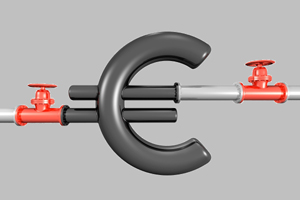'The European gas market is not designed for spot market prices'
on
With spot market gas prices noticeably lower compared to oil-indexed long-term contract prices, more and more calls are heard in Europe to abandon the traditional gas pricing structure and embrace the “spot market model”. Sergei Komlev, Head of the Contract Structuring and Price Formation Directorate at Gazprom Export, warns that such a policy might look attractive in the short term, but would entail price and security of supply risks for Europe in the longer term. ‘The European gas market is not designed for the spot market pricing model’, he argues.
 |
| 'With demand looking to pick up again, spot gas prices are bound to bounce back' |
Calls to “break open” the European gas market are nothing new. Since the EU embraced the liberalisation of the energy market in 1998, it has been actively working to break up the traditional gas market model, which relies on vertically integrated “national” energy companies in the EU buying foreign gas on the basis of long-term contracts. Instead, Brussels is trying to encourage an “Anglo-Saxon” model in which most gas is bought and sold through spot contracts by traders and suppliers who have “equal access” to pipelines and gas hubs.
Current market circumstances lend extra weight to the EU’s arguments. Whereas spot prices for oil and gas moved pretty much in tandem for many decades, since 2008 the two have started to drift apart. Oil is now roughly three times as expensive as gas. This means that customers in Europe and Asia who buy gas under oil-linked long-term contracts pay much more for their gas than buyers in the liberalised UK and (particularly) US markets.
Risky strategy
So would Europe be better off if it gradually got rid of the long-term contracts and adopted the US model? Gazprom, which satisfies roughly a quarter of Europe’s gas demand, certainly does not think so. On the contrary. According to Sergei Komlev, who is in charge of the Russian giant’s long-term contracts – and Gazprom sells most of its gas under such contracts – believes Brussels is pursuing a risky strategy, that will ultimately undermine its own security of supply and will make both the EU and Russia worse off.
According to Komlev, who recently visited Amsterdam where he explained his views at a gas conference, it is misplaced to think that the current situation of extremely low spot prices for gas is sustainable. ‘Brussels thinks this is a normal situation, but it is not. It is abnormal. It will not last. Neither in the US nor in Europe.’
The US Energy Information Administration (EIA) has recently published a report that assumes that the current oil to gas price ratio of 3:1 will stay roughly the same until at least 2035. Komlev, however,
| ‘The fact that some shale gas developers managed to be profitable, was only because they were able to hedge their sales’ |
As all market watchers know, the main reason for the low gas prices in the US is the enormous success of shale gas and other “unconventional” gas that has flooded the American market in the past few years. The EIA, says Komlev, assumes that this shale gas “miracle” has changed the fundamentals of the gas market. Komlev doubts this assumption, however. Based on recent research Gazprom Export has done, he is convinced that US gas prices are bound to bounce back soon.
Gazprom Export has had an analysis made of the cost structure of the ten largest US shale gas developers which concludes that in 2009 these companies faced ‘all-in costs’ (the sum of operating costs plus depletion, depreciation and amortization costs) of $6 per million cubic feet (mcf) on average. Spot prices were well below this level. The fact that some of the developers nonetheless managed to be profitable, says Gazprom Export, was because they were able to hedge their sales – i.e. they managed to sell their gas at higher future prices. Gazprom has calculated that the average price the shale developers realised in 2009 was $3.63 per mcf excluding the effects of hedging. The positive impact of hedging was on average $2.25 per mcf. Thus, the average revenue for the developers was $5.88. At this price level, half of them managed to turn in a profit.
 |
| Would Europe be better off if it gradually got rid of the long-term contracts and adopted the US-model? |
Delicate balance
Then there is the demand side of the market to take into account. Once the economy will come out of the recession, demand is bound to recover. All the major energy consultancies, such as CERA, Wood Mackenzie and PIRA, predict solid demand growth in 2011-2012, says Komlev. In the longer term, according to most forecasters, EU gas consumption will grow by 150 bcm (billion cubic meters) to over 700 bcm in 2030. At the same time, domestic gas production in the EU will decline. This means that imports will rise even faster than demand. Based on the figures of the major energy consultancies, Gazprom forecasts that EU imports will rise from 300 bcm now to 380 bcm by 2020 and 440 bcm by 2030.
It is unrealistic to expect that such large amounts of gas will be supplied through spot market prices, Komlev argues. He points out that in 2009 a mere 30 bcm was actually traded on the European spot
| ‘These contracts represent a delicate balance of interests among all parties’ |
But Komlev says that it will be hard for Russia to make these huge future commitments without the security provided by long-term contracts. He notes that Gazprom has to look ahead when it is planning investments. ‘We cannot do this under a spot market system. Long term contracts provide security to both recipient and supplier and guarantee a stable price, particularly important in these times of financial uncertainty in the European markets.’ Hence, he concludes that ‘the European gas market is not designed for the “Anglo-Saxon” spot market model’.
Komlev stresses that Gazprom is not inflexible when it comes to adapting to changing market circumstances. ‘The company has used existing flexibility clauses in some of its major Long Term Contracts, adjusting them to the new market realities.’ But, he adds, this did not change the principles behind the contracts. ‘These contracts represent a delicate balance of interests among all parties.’
But his main message is that the present pricing system has served Europe well for many decades. To change it just because of the current unusual market conditions is, in Komlev’s view, unnecessary and not in the interests of either recipients or suppliers.


Discussion (0 comments)